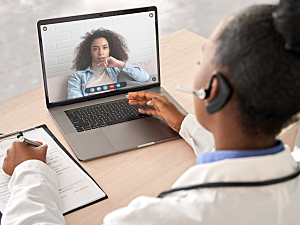The use of telemedicine in spine care rapidly increased out of necessity to aid physical distancing at the start of the COVID-19 pandemic. High utilization is expected to continue because of benefits including greater access to care, high patient satisfaction, and substantial cost savings.
The Telemedicine Working Group of AO Spine, a global academic community, convened an expert panel to attempt to reach a consensus on practical aspects of telemedicine related to spine care. Melvin C. Makhni, MD, director of Complex Spine Surgery in the Department of Orthopaedic Surgery at Brigham and Women’s Hospital, served as senior author of the report, which appears in Spine (Phila Pa 1976).
Methods
The panel, assembled in February 2021, included 22 academic orthopedic surgeons and five neurosurgeons. 22 surgeons were from the U.S., and five other countries were represented. Both junior and senior surgeons were invited from both specialties, and years in practice ranged from one to 34.
A two-round Delphi method was used to generate 59 statements on various aspects of video-based telemedicine (VT) and audio-based telemedicine (AT). Positive consensus on a statement was defined as ≥75% agreement among participants, and negative consensus (e.g., the decision that a procedure is inappropriate) was based on ≥75% disagreement.
Patient’s Geographic Location
The panel agreed that VT is safe and appropriate for patients located in a different state or county (there was no consensus on AT).
Assessment of New Patients
There was both positive and negative consensus about telemedicine for new patients:
- Lumbar stenosis, lumbar radiculopathy, or cervical radiculopathy can be adequately diagnosed and indicated for surgery using VT
- Cervical myelopathy can be diagnosed with AT but should not be indicated for surgery using AT
- Spinal deformity should not be evaluated or indicated for surgery via AT
Physical Examination
An agreement was reached on only two factors related to physical examination: it is possible to evaluate for gait abnormalities using VT, and special tests for myelopathy should not be performed via VT.
In-Person Visits Before Surgery
There was consensus that in-person evaluation before surgery is:
- Best practice for patients who had initial VT evaluation for cervical myelopathy, cervical radiculopathy, or deformity
- Necessary for patients who had initial VT evaluation for cervical myelopathy or spinal deformity
Acceptable Visit Types
The panel judged both VT and AT to be appropriate for:
- The early postoperative visit (2–6 weeks)
- The mid-term postoperative visit (3–6 months)
- Longer-term postoperative visits (>6 months)
- Follow-up visits for imaging review
- Follow-up visits after an intervention (e.g., injection, physical therapy)
There was also consensus that an AT visit is unsuitable for postoperative wound issues.
The panel reached strong agreement (≥66% to 74%) on seven items, such as that VT is appropriate for addressing postoperative wound issues. On 20 items, there was no consensus, suggesting the need for further research and discussion about telemedicine in spine care.
